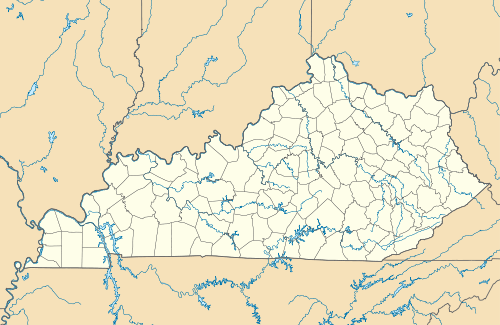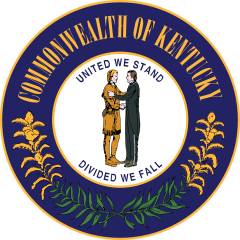Mill Springs Battlefield
|
Battle of Mill Springs Historic Areas | |
|
| |
|
Visitors Center | |
 | |
| Location | Pulaski / Wayne counties, Kentucky, USA |
|---|---|
| Nearest city | Nancy, Kentucky |
| Coordinates | 37°0′19″N 84°45′28″W / 37.00528°N 84.75778°WCoordinates: 37°0′19″N 84°45′28″W / 37.00528°N 84.75778°W |
| Built | 1862 |
| Governing body | Local |
| NRHP Reference # | 93000001[1] |
| Added to NRHP | February 18, 1993 |
The Mill Springs Battlefield was the location of the Battle of Mill Springs in January, 1862. It was declared to be a U.S. National Historic Landmark in 1993.
Several separated areas related to the battle have been listed on the National Register of Historic Places: the Confederate Mass Grave Monument in Somerset, Gen. Felix K. Zollicoffer Monument, and the Mill Springs National Cemetery. Alternative names for the areas include: WN-2;WN-24;WN-73;PU-131.
Area
The initial designated area for the National Register of Historic Places included three separate areas: the battlefield, and two separate areas with Confederate fortifications on each side of Lake Cumberland (one near Mill Springs, and the other by Beech Grove). The three separate areas amounted to 647.3 acres (2.620 km2) of land, most of which is in Pulaski County, Kentucky (the battlefield), with the rest in Wayne County, Kentucky.[2]
The main difference in the land from 1862 to the modern day is that the landscape is less wooded. Also the name of the town during the battle was Logan's Crossing, when today it is called Nancy. There are no buildings left that were standing during the war, although none of modern buildings seriously detracted from the area's National Register status. Two of the 29 noncontributing structures on the battlefield during the nomination were later were placed on the National Register; both were monuments placed on the battlefield in 1910.[3]
Visitor Center and Museum
The Mill Springs Battlefield Visitors Center and Museum commemorates the January 1862 Battle of Mill Springs, fought during the early days of the American Civil War. The museum is located in Nancy, Kentucky, just past the northern edge of the battlefield, overlooking where Union forces camped. It is adjacent to the Mill Springs National Cemetery, which contains the Federal interments (the Confederate burials are at Zollicoffer Park, a short distance away, on the battlefield proper). The museum was formally dedicated on November 4, 2006.
Operated by the Mill Springs Battlefield Association, the museum consists of a central foyer where greeters welcome guests and direct them to the various parts of the museum, which consists of a community room, library, legacy room, and exhibition hall, as well as a gift shop. There is also a high-security space for traveling exhibits. The Brown-Lanier House, used as a headquarters during the battle, is also owned by the Battlefield Association. It is maintained as a bed and breakfast.
On January 15, 2013, Kentucky Representative Hal Rogers introduced the bill H.R. 298, officially titled "To direct the Secretary of the Interior to conduct a special resource study to evaluate the significance of the Mill Springs Battlefield located in Pulaski and Wayne Counties, Kentucky, and the feasibility of its inclusion in the National Park System, and for other purposes," into the United States Congress.[4] The bill would direct the Secretary of the Interior to conduct a special resource study to evaluate the significance of the Mill Springs Battlefield in Kentucky (relating to the Battle of Mill Springs fought on January 19, 1862, in Pulaski and Wayne Counties during the Civil War) and the feasibility of its inclusion in the National Park System (NPS).[4][5] Rogers said that "the Battle of Mill Springs is a source of great pride and interest to the people I serve."[6] Rogers argued that the Battlefield was a "jewel" and would be "an excellent addition to the National Park Service."[6]
Zollicoffer Park
Zollicoffer Park features two separate monuments that are on the National Register of Historic Places. These are the General Felix K. Zollicoffer Monument just inside the park, and the Confederate Mass Grave Monument in Somerset which is further into the park. Both were built due to a local girl by the name of Dorotha Burton decorating a white oak tree in Confederate general Felix K. Zollicoffer's honor, who had died in the battle after failing to realize he was close to the Union lines; he thought he was close to his Confederate lines. In 1995 the tree was destroyed during a lightning storm, but a sapling from that tree was put in its place in 1997, and is also called the Zollie tree.[7][8]
Notes
- ↑ "National Register Information System". National Register of Historic Places. National Park Service. 2009-03-13.
- ↑ Brent p.4
- ↑ Brent p.6
- ↑ 4.0 4.1 "H.R. 298 - Summary". United States Congress. Retrieved 28 April 2014.
- ↑ Marcos, Cristina (28 April 2014). "House votes to allow more DC penthouses". The Hill. Retrieved 29 April 2014.
- ↑ 6.0 6.1 Smoot, Danielle (28 April 2014). "Rogers' Mill Springs Battlefield Bill Moves Forward". Office of Hal Rogers. Retrieved 29 April 2014.
- ↑ "Nancy, Ky.". WMTH Corporation. Retrieved 2009-05-17.
- ↑ "Mill Springs Battlefield". The Blue and Gray Trail. Retrieved 2009-05-17.
References
- "It's Open!", The Zollie Tree, V. XI, No. 7, Winter 2007 (newsletter of the Mill Springs Battlefield Association)
- Somerset, Kentucky Commonwealth-Journal, "Here’s Hoping Battlefield Will Survive Turmoil", January 19, 2007
- Brent, Joseph E. (1993). "Battle of Mill Springs Historic Areas NRHP Nomination Form". Kentucky Heritage Council.
External links
- Mill Springs Battlefield Association
- The Battle of Mill Springs: The Civil War Divides a Border State, a National Park Service Teaching with Historic Places (TwHP) lesson plan
| |||||||||||||||||||||||||||||||||

.svg.png)